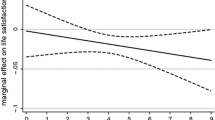Abstract
This study uses large cross-country samples and several measures of happiness, income, and government spending to revisit the relation between government spending and the population’s happiness. The main finding is that increased government spending does not lower happiness in broad cross-country contexts. Much caution is, therefore, urged in interpreting the negative association between government spending and happiness reported in some earlier studies and the suggested policy implications. Three additional points are noted. First, the weight of the evidence suggests a significant positive association between income and happiness. Second, estimates based on income and government-share data from Penn World Table and the new International Comparison Program show similar patterns. Third, the parameter for generalized trust seems fragile.
Similar content being viewed by others
References
Bjornskov, C. (2007). Determinants of generalized trust: A cross-country comparison. Public Choice, 130, 1–21.
Bjornskov, C., Dreher, A., & Fischer, J. A. V. (2007). The bigger the better? Evidence of the effect of government size on life satisfaction around the world. Public Choice, 130, 267–292.
Eurostat. (2007). Eurostat-OECD methodological manual on purchasing power parities. Paris: OECD.
Heston, A., Summers, R., & Aten, B. (2006). Penn world table version 6.2, Center for International Comparisons of Production, Income and Prices, University of Pennsylvania.
Inglehart, R. (2008). Subjective well-being in 97 countries. Personal correspondence, July 2008.
Kacapyr, E. (2008). Cross-country determinants of satisfaction with life. International Journal of Social Economics, 35, 400–416.
New Economics Foundation. (2006). The unhappy planet index. London: NEF.
Ram, R. (2008). International income distribution: Comparing the new ICP and the existing data. Illinois State University, Normal, IL., USA.
Veenhoven, R. (2006). Average happiness in 95 nations 1995–2005, world database of happiness, Rank report 2006-1d. Internet: worlddatabaseofhappiness.eur.nl (accessed 5 July 2008).
White, H. (1980). A heteroskedasticity-consistent covariance matrix estimator and a direct test for heteroskedasticity. Econometrica, 48, 817–838.
World Bank. (2008). 2005 international comparison program: tables of final results. Washington: World Bank.
Author information
Authors and Affiliations
Corresponding author
Rights and permissions
About this article
Cite this article
Ram, R. Government spending and happiness of the population: additional evidence from large cross-country samples. Public Choice 138, 483–490 (2009). https://doi.org/10.1007/s11127-008-9372-0
Received:
Accepted:
Published:
Issue Date:
DOI: https://doi.org/10.1007/s11127-008-9372-0




